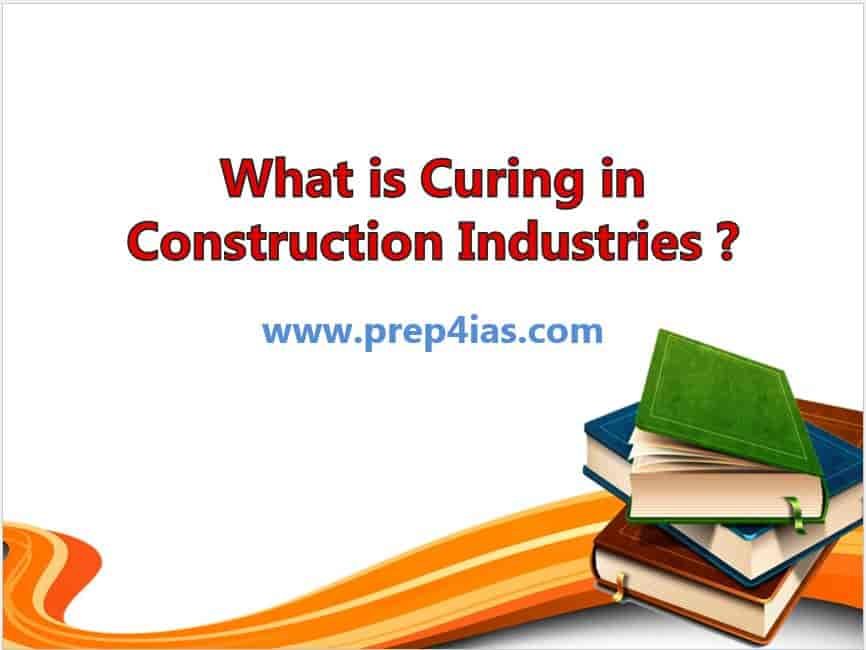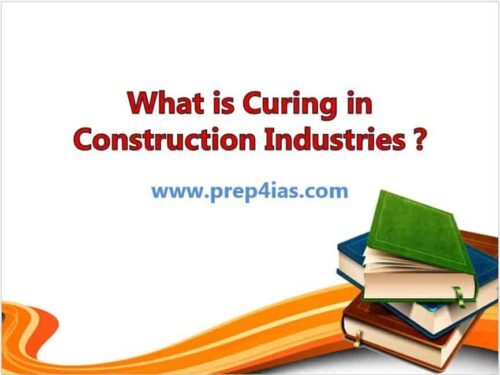Curing is a crucial process in the construction industry, specifically in the context of concrete works. It refers to the maintenance of adequate moisture, temperature, and time conditions to allow concrete or cement-based materials to achieve their designed strength and durability. The curing process begins immediately after the concrete has been placed and finished, and it is essential for the hydration process of the cement, which is the chemical reaction between cement and water that leads to the hardening and strengthening of the concrete.

Key Aspects of Curing
Also Read: What is a Plinth in Construction ?
The key aspects of curing revolve around controlling the environment in which the concrete sets and hardens to ensure optimal hydration of the cement. The main aspects include:-
1. Moisture Retention
- Objective: To prevent the premature loss of water from the concrete. Adequate moisture is essential for the continued hydration of cement, which is the chemical reaction responsible for concrete's strength gain.
- Methods: Techniques include water curing (ponding, spraying, or covering with wet burlap), applying membrane-forming curing compounds, or using impermeable coverings.
2. Temperature Control
- Objective: To maintain the concrete at a temperature conducive to hydration. Both excessively high and low temperatures can adversely affect the strength development and durability of concrete.
- Methods: In hot conditions, measures might include cooling the concrete ingredients, shading, or misting. In cold conditions, insulated blankets, heated enclosures, or additives that accelerate hydration can be used.
3. Time Duration
- Objective: To ensure that curing is maintained for a sufficient period to allow significant hydration of the cement. The appropriate duration depends on the type of cement, mix proportions, ambient conditions, and the concrete's intended use.
- Standard Practice: A minimum of 7 days for ordinary Portland cement under temperate conditions is commonly recommended, but longer periods may be beneficial, especially for mixes with supplementary cementitious materials.
4. Hydration Process
- Objective: To facilitate the chemical reaction between water and cement, which forms the hardened matrix of the concrete.
- Considerations: The extent and rate of hydration influence the concrete's final properties, including strength, durability, and resistance to environmental factors.
5. Environmental Protection
- Objective: To shield fresh concrete from adverse environmental conditions that can hinder the curing process, such as wind, sun, and temperature extremes.
- Methods: Using windbreaks, sunshades, fog sprays, or temperature-controlled enclosures can help protect the concrete during critical early stages of curing.
6. Application and Monitoring
- Objective: To ensure the chosen curing method is correctly applied and maintained throughout the necessary curing duration.
- Practice: Regular inspection and monitoring are essential to adjust curing practices as required by changing environmental conditions or observed concrete behavior.
7. Post-Curing Handling
- Objective: To manage the transition from the end of the active curing period to the concrete being put into service, ensuring it has gained sufficient strength and stability.
- Considerations: This includes timing the removal of forms, post-curing treatments, and avoiding premature loading or exposure to aggressive environments.
Also Read
Methods of Curing
Different methods of curing concrete are employed to ensure that it develops the desired strength and durability. These methods are designed to maintain adequate moisture content and favorable temperature conditions during the early stages of concrete setting and hardening. Here are some of the most common curing methods:-
1. Water Curing
- Ponding: Small ponds of water are formed on horizontal surfaces, such as slabs, by building temporary dams around the concrete.
- Immersion: Prefabricated concrete elements are submerged in water tanks or ponds.
- Spraying or Fogging: Water is sprayed or fogged over the concrete surface, ideal for large areas and in warm climates to prevent rapid drying.
- Wet Coverings: Materials like burlap, cotton mats, or hessian are soaked in water and placed over the concrete surface. These coverings need to be kept constantly wet.
2. Membrane Curing
- Curing Compounds: Chemical compounds that form a water-impermeable layer on the concrete surface, preventing moisture loss. They are sprayed over the concrete and are useful where water curing is impractical.
3. Steam Curing
- At Atmospheric Pressure: Used primarily in precast concrete factories, this method involves exposing the concrete to steam at atmospheric pressure, which accelerates the curing process.
- In Autoclaves: High-pressure steam curing in sealed chambers, used for products like AAC (Autoclaved Aerated Concrete) blocks, increases the rate of strength gain.
4. Internal Moisture Curing
- Internal Curing: Lightweight aggregates or superabsorbent polymers (SAPs) that have been pre-soaked in water are mixed into the concrete. These materials release water from within, aiding the hydration process.
5. Insulation
- Thermal Insulation: Insulating blankets or covers are used to retain heat in the concrete during cold weather, promoting the curing process by keeping the temperature within a favorable range.
6. Electrical Curing
- Electric Curing: An electrical current is passed through the concrete to generate heat internally, thereby accelerating the curing process. This method is less common and used for specific applications.
7. Infrared Curing
- Infrared Radiation: Infrared lamps are used to provide heat to the concrete surface, enhancing the curing process by maintaining optimal temperatures.
8. High-Frequency Vibration Curing
- Vibration: High-frequency vibrations are applied to fresh concrete, which can increase the rate of cement hydration and thus strength gain.
Conclusion
Curing is essential for achieving the desired strength and durability of concrete, reducing permeability, improving wear resistance, and increasing resistance to freezing and thawing cycles. Proper curing practices are vital for the long-term performance and structural integrity of concrete structures.

